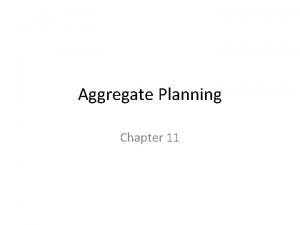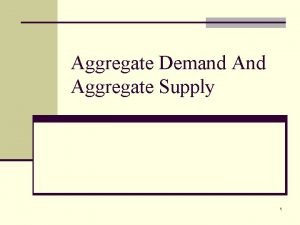Human Resource Planning Types of Planning Aggregate planning










- Slides: 10

Human Resource Planning Types of Planning • Aggregate planning • Anticipates needs for groups of employees in specific, usually lower level jobs and general skills employee need to ensure sustained high performance • Succession planning • Focuses on key individuals management positions that the organization needs to make sure remain filled and the type of individuals who might provide the best fit in these critical positions.

Types of Planning Aggregate planning: • First step in aggregate planning is forecasting the demand for employees • Organization needs to consider its strategic plan and kinds and rates of growth that may be planned • Greatest indicator of the demand for employees is demand for the organization’s product and services • Assumption that might affect utilization of employees: – – – Competition Changes in production or services Technology Quality or customer service Redesign or work system

Types of Planning Aggregate planning: • Unit forecasting • Bottom up planning – Each individual unit, department, or branch of the organization estimates its future needs for employees – Each branch might prepare its own forecast based on the goals and objectives each branch manger has for the particular office – These estimates then presented to senior management for approval – This techniques is most responsive to the needs of the market place because it places responsibility for estimating employee needs at the point of contact Advantages or disadvantages? ?

Types of Planning • Top down planning – Senior mangers allocating a budgeted amount for employee payroll expenditures and then dividing the pool at subsequent level down the hierarchy – Each manager receive the budget from supervisor and then decide how to allocate to the next level – Sales and profit plans in many organizations where by each unit is assigned budgeted amount and then required to make decisions on deploying those resources in the manner most consistent with business objectives – Efficient? ? – Response to market place? ? ? – What organization can afford? ? ?

Types of Planning • Unit forecasting responsive to customers and the market place • Top-down forecasting promotes organizational efficiency in resource allocation • Depends on organization what to chose it cost minimization then may be top down approach is appropriate choice and if its strategy is related to responsiveness and efficiency then it is possible to use both forms forecasting and have middle levels of management.

Types of Planning • Strategies for managing employees shortages and surpluses • Shortages: – Recruit new permanent employees – Offer incentives to postpone retirement – Rehire retirees part time – Attempt to reduce turnover – Work current staff overtime – Subcontract work out – Hire temporary employees – Redesign job processes so that fewer employees are needed

Types of Planning • Strategies for managing surpluses – Hiring freezes – Don’t replace those who leave – Offer early retirement incentives – Reduce work hours – Layoffs – Reduce outsourced work – Employee training – Switch to variable payplan – Expand operations

It involves: Succession Planning • Identifying key management positions that the organization cannot afford to have vacant • Senior management positions normally • Succession planning serves two purposes 1. Succession planning facilitates transition when an employee leaves 2. Succession planning identifies the development needs of high potential employees and assists with their career planning

Succession Planning Replacement charts: • Planning tool • Identify key positions, possible successors for each of these positions • Easily derived from organization charts • Part of HR information system • Should be systematic • It may contain specific skills as well • It allows organization to provide its high potential employees with more specific feedback regarding developmental needs • It helps to identify critical training managers and the organization as a whole

Objectives of HR Planning Disadvantages Advantages Don’t tell High performers may leave the organization, unsure of their future Allows flexibility as business needs changes Tell Unrealistic expectations and implied contracts Retention strategy
 Sras lras
Sras lras Ad curve graph
Ad curve graph Cannot mix aggregate and non-aggregate tableau
Cannot mix aggregate and non-aggregate tableau Aggregate supply shifters
Aggregate supply shifters Tax multiplier formula
Tax multiplier formula Unit 3 aggregate demand aggregate supply and fiscal policy
Unit 3 aggregate demand aggregate supply and fiscal policy Perencanaan kapasitas dan agregat
Perencanaan kapasitas dan agregat Aggregate capacity planning
Aggregate capacity planning Capacity aggregation example
Capacity aggregation example Forecasting techniques in hrm
Forecasting techniques in hrm Long term hr planning
Long term hr planning


















